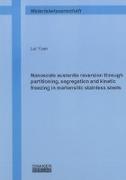- Start
- Nanoscale austenite reversion through partitioning, segregation and kinetic freezing in martensitic stainless steels
Nanoscale austenite reversion through partitioning, segregation and kinetic freezing in martensitic stainless steels
Angebote / Angebote:
In this thesis, the approach is to increase the amount of austenite during low-temperature austenite reversion heat treatment. The heat treatment starts with a complete austenitization and carbides solution treatment. Water quenching to room temperature is followed after this solution treatment. During a subsequent heat treatment in the range of 300°C-500°C, austenite reversion takes place on the basis of partial partitioning according to local equilibrium, segregation and kinetic freezing of carbon among different phases. This austenite reversion treatment was applied in two kinds of martensitic stainless steels: Fe-13Cr-0.4C (X44Cr13, 1.4034, AISI 420) and Fe-13Cr-0.2C (X21Cr13, 1.4021, AISI 420) (wt.%).
In the high carbon steel (Fe-13Cr-0.4C), austenite reversion heat treatment at 400°C gives the material a significant increase in ductility without drastically strength decrease (e.g. heat treated at 400 °C for 30 min results in a UTS of 1.75 GPa with an elongation of 23%).
Concerning the whole austenite reversion treatment, carbon concentration and its distribution are the key factors. During quenching, in the vicinity of martensite-austenite interfaces, carbon segregates from the supersaturated martensite to both, the hetero-interfaces and to homophase grain boundaries. During austenite reversion tempering, carbon continuously diffuse to martensite-austenite interfaces, driving the carbon-enriched areas towards austenite reversion. It is worthy to point out that the fast nanoscale austenite reversion is attributed to an effect that is referred to as kinetic freezing of carbon. This means that the carbon is fast inside the martensite when leaving it but slow (and, hence, frozen) when entering the austenite. Carbon becomes trapped and highly enriched at the martensite-austenite interfaces owing to its low mobility within the austenite during low-temperature partitioning. This provides a much higher local driving force for austenite reversion. This means that the formation of nanoscaled reverted austenite depends mainly on the local but not on the global chemical potential of carbon at internal interfaces. Carbon inside martensite, far away from any interfaces, tends to form M3C carbides.
The austenite reversion process, nano-carbide precipitation, and carbon segregation have been characterized by X-ray diffraction (XRD), electron back-scatter diffraction (EBSD), transmission electron microscopy (TEM) and atom probe tomography (APT) in order to develop the structureproperty relationships that control the material's strength and ductility. 3D reconstructions of samples at different stages during austenite reversion treatment were established base on the APT results especially at the interfaces.
In the low carbon steel (Fe-13Cr-0.2C), austenite reversion in the investigated temperature range (300°C-500°C) is difficult to proceed due to the lack of carbon content. Simple tempering of the quenched martensite is the main process of this steel when heat-treated at 400°C.
Libri-Titel folgt in ca. 2 Arbeitstagen

